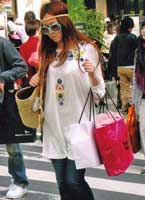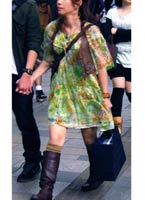|
SEVENTIES FOLK FASHIONS REVISITED
Vintage Clothing Shops Drive Revival
|
|
"Folklore-style" A-line dresses embellished with embroidery or Tyrolean ribbons are a hit among young women in their teens and twenties. Tunic blouses are also increasingly prominent as women take to wearing tunics with colorfully embroidered bodices and crochet-lace trim over leggings or skinny jeans. Folklore-style dresses and tunics have an untailored look, featuring gathers, frills, and other details in white or beige cotton fabric. When paired with large half-moon sunglasses, fringe boots, or high-heeled sandals, however, a well-balanced seventies look can be achieved. Seventies hairstyles are also popular, such as long hair parted in the center or a narrow headband worn on the forehead. The Roots of the Folklore Style In the 1970s, the fashion scene underwent a transformation when Takada Kenzo, Yves Saint Laurent, and other designers unveiled looks inspired by the traditional dress of Eastern Europe, the Middle East, and other regions. The folklore style made a comeback in the 1990s and is experiencing another boom in 2008. The Appeal of Folklore Fashion What accounts for the popularity of seventies-style ethnic clothes? The floral patterns, embroidery, and other embellishments accord with the romantic style that is currently popular. Many are attracted by their inexpensive price tags as well and intimate feel, which make them the antithesis of luxury brands. The natural fabrics and soft texture also seem to be in line with today's eco-friendly mindset. (July, 2008) |
Copyright (C)2008 Web Japan. Edited by Japan Echo Inc. based on domestic Japanese news sources. Articles presented here are offered for reference purposes and do not necessarily represent the policy or views of the Japanese Government.

